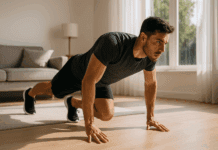Introduction: Unlocking the Power of Your Own Body
In a world where gym memberships, expensive equipment, and fitness fads often overshadow simplicity, many overlook the incredible power of the human body as a tool for transformation. A well-structured bodyweight strength program offers a time-tested, effective way to build real muscle, improve performance, and master functional movement—all without lifting a single weight. This article explores how anyone, from beginners to seasoned athletes, can unlock their strength potential using only gravity, consistency, and determination.
The resurgence of interest in bodyweight training is no accident. With increasing access to research-backed methods and a growing appreciation for minimalist, functional fitness, more people are turning to bodyweight routines as their primary mode of strength development. Not only does a bodyweight strength program allow for scalable progression and injury prevention, but it also fosters body awareness, balance, and mobility in ways that traditional weightlifting often neglects. Whether your goal is hypertrophy, athletic enhancement, or simply being stronger and more resilient in daily life, this approach holds transformative potential.
You may also like: The Essential Role of Carbs for Muscle Growth in High-Protein Diet Success
Why Bodyweight Training Is Ideal for Building Strength and Muscle
The idea that you need heavy weights to build muscle is an outdated myth. Modern research shows that muscular development is largely influenced by mechanical tension, metabolic stress, and muscle damage—all of which can be achieved through body weight exercises. The key lies in manipulating variables such as tempo, volume, range of motion, and exercise complexity.
Bodyweight exercises like push-ups, pull-ups, and squats can be modified to create progressive overload, the essential stimulus for muscle growth. Techniques such as slow eccentrics, isometric holds, explosive reps, and increased time under tension allow the muscles to adapt and grow over time. In fact, bodyweight exercises for muscle gain can be just as effective as resistance training when executed with intention and structure.
Another benefit of this approach is that it enables a full-body stimulus with minimal risk. Unlike machines that isolate and restrict natural movement patterns, bodyweight workouts encourage dynamic, compound motion that recruits stabilizing muscles, promotes joint health, and improves coordination. For those seeking a sustainable and adaptable fitness path, bodyweight strength is not only viable—it’s essential.

Essential Principles of a Successful Bodyweight Strength Program
For a bodyweight strength program to be effective, it must be grounded in foundational principles that align with exercise science and the body’s adaptive responses. These principles guide how to structure workouts, increase difficulty, and sustain long-term progression.
The first principle is progressive overload. Even without weights, this can be achieved by increasing repetitions, manipulating leverage, slowing down movements, adding isometric pauses, or advancing to more challenging variations. For instance, progressing from incline push-ups to archer push-ups to one-arm push-ups represents a continuum of increasing resistance through body positioning.
Next is frequency and volume. A bodyweight training plan typically benefits from higher frequency since the recovery demand is often lower than heavy lifting. Training three to five times per week allows for both neuromuscular adaptation and muscular endurance gains. Volume—total sets and reps—can be adjusted based on your experience level and goals.
Equally important is balanced programming. The best bodyweight workouts train all major muscle groups: pushing (chest, shoulders, triceps), pulling (back, biceps), lower body (quads, hamstrings, glutes, calves), and core. Ignoring any movement pattern can lead to muscular imbalances and eventual injury. A strategic plan incorporates push-pull symmetry and anterior-posterior chain alignment to create holistic strength.
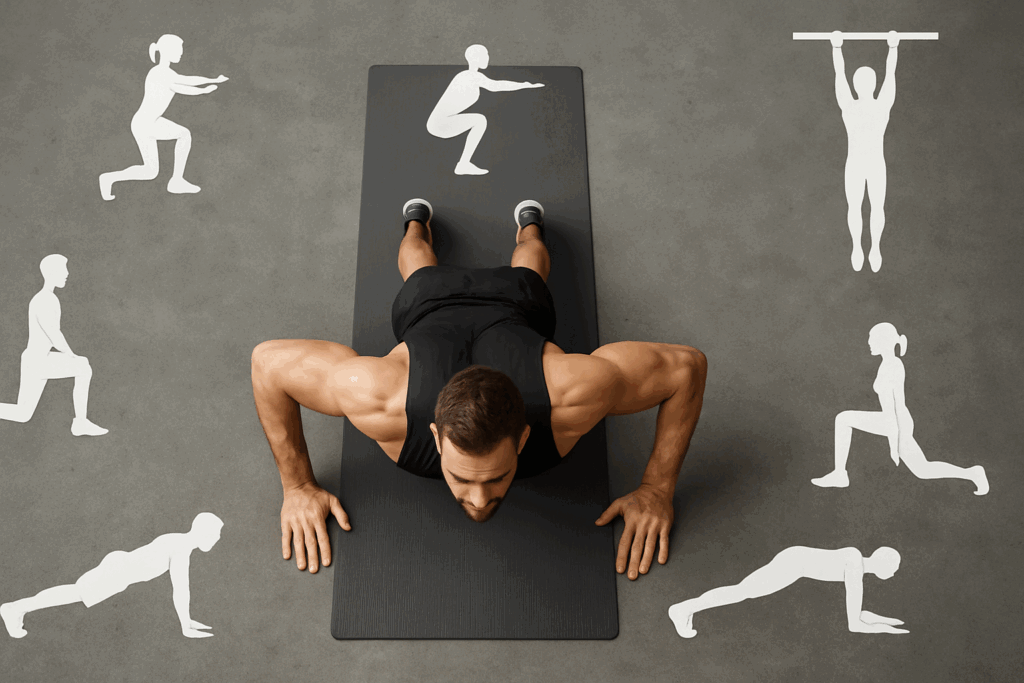
Building the Foundation: The Best Bodyweight Exercises for Beginners
Starting with a solid foundation is critical. A well-designed bodyweight beginner routine introduces the mechanics of movement, ensures joint safety, and fosters neuromuscular control. Instead of rushing into advanced exercises, beginners should first master basic patterns such as squatting, hinging, pushing, pulling, and bracing.
Bodyweight squats teach mobility and hip-knee coordination. Push-ups build upper body pushing strength while challenging core stability. Glute bridges activate the posterior chain. Wall sits and planks develop isometric strength and endurance. Rows using a suspension trainer or under a sturdy table introduce pulling strength, which is often neglected in bodyweight-only routines.
These movements not only lay the groundwork for more complex exercises but also serve as diagnostic tools. They reveal asymmetries, mobility limitations, and areas of weakness that can be addressed early. By committing to consistency and refinement in these foundational movements, beginners will create a strong base for lifelong progress.

Progressive Overload in a Bodyweight Strength Program
One of the most powerful strategies in any bodyweight strength program is learning how to apply progressive overload effectively. Because bodyweight exercises are limited by the fact that your resistance (i.e., your body) doesn’t change easily, creativity and precision become essential.
For upper body pushing, progression might look like moving from knee push-ups to full push-ups, then to deficit push-ups (hands elevated), and eventually to explosive clapping push-ups or archer push-ups. Pulling strength evolves from horizontal rows to inverted rows, pull-ups, and eventually one-arm variations. Lower body progressions include squats to jump squats, pistol squats, and eventually airborne lunges.
In addition to movement progression, advanced training variables enhance overload. Time under tension (slowing the eccentric phase), adding isometric holds, and using partial range reps in combination with full reps can make even basic movements extremely challenging. Structured deloading and recovery cycles ensure that these demands lead to growth, not burnout.
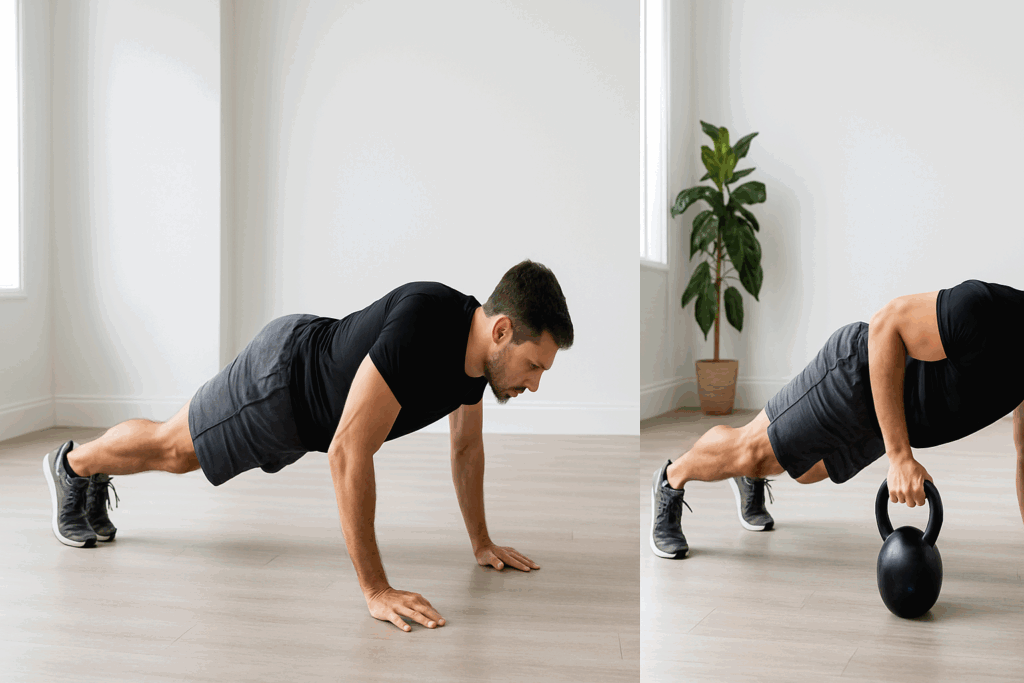
Designing Your Personalized Bodyweight Workout Plan
Every effective bodyweight workout plan begins with personalization. Fitness goals, training experience, time availability, and physical limitations all influence what your plan should look like. Designing your own bodyweight exercise plan empowers you to align your training with your lifestyle and goals.
A sample weekly split might involve three full-body sessions for beginners, with one day dedicated to core work and mobility. Intermediate athletes may follow a push-pull-legs split across four to five sessions. Advanced practitioners can add skill-focused days for exercises like handstands, muscle-ups, or planches.
Each session should include a warm-up (mobility, dynamic stretching), a strength component (primary movements with progressive sets), accessory work (unilateral training, core, mobility), and a cool-down. Training logs and regular assessments help you track progress and stay motivated. Whether you’re using a formal bodyweight workout program or creating your own, structure ensures consistent and measurable outcomes.

The Science Behind Muscle Gain Without Weights
Can bodyweight exercises build muscle? This question has intrigued researchers and athletes alike. The answer, supported by numerous studies, is a resounding yes. As long as the body is subjected to mechanical tension and metabolic stress beyond its current capacity, hypertrophy can occur.
Metabolic stress—the “burn” associated with higher rep sets—promotes hormonal changes and cell swelling, both of which play a role in muscle adaptation. Paired with sufficient volume and intensity, these effects rival those seen in traditional resistance training. In fact, does body weight exercises build muscle? Yes, and in many cases, it offers a safer and more accessible alternative to external loads.
Moreover, muscle recruitment patterns in bodyweight training are highly functional. When performing a full body bodyweight workout, multiple joints and muscle groups work synergistically, promoting balanced development and injury resistance. For individuals recovering from injury, managing chronic conditions, or training at home, this method offers a practical and effective path to muscular development.
The Best Bodyweight Exercises to Build Muscle Across the Entire Body
When considering the best bodyweight exercises, it’s important to choose movements that engage large muscle groups, challenge stability, and allow for scalable progression. For upper body strength, push-ups (and their many variations) form the cornerstone. Explosive push-ups, archer push-ups, and pseudo planche push-ups challenge different parts of the chest, shoulders, and triceps.
Pulling movements, including pull-ups, chin-ups, and horizontal rows, target the back and biceps. In the absence of equipment, towel rows or doorframe rows provide useful alternatives. Lower body strength thrives on exercises like squats, Bulgarian split squats, glute bridges, and step-ups. Pistol squats are the ultimate test of unilateral lower-body control and strength.
Core training in bodyweight exercise programs is far more than just sit-ups. Planks, hollow holds, leg raises, and windshield wipers build anti-extension and anti-rotation strength critical for athletic performance. By incorporating these exercises into a bodyweight workout routine, you target the full kinetic chain and ensure muscular symmetry.
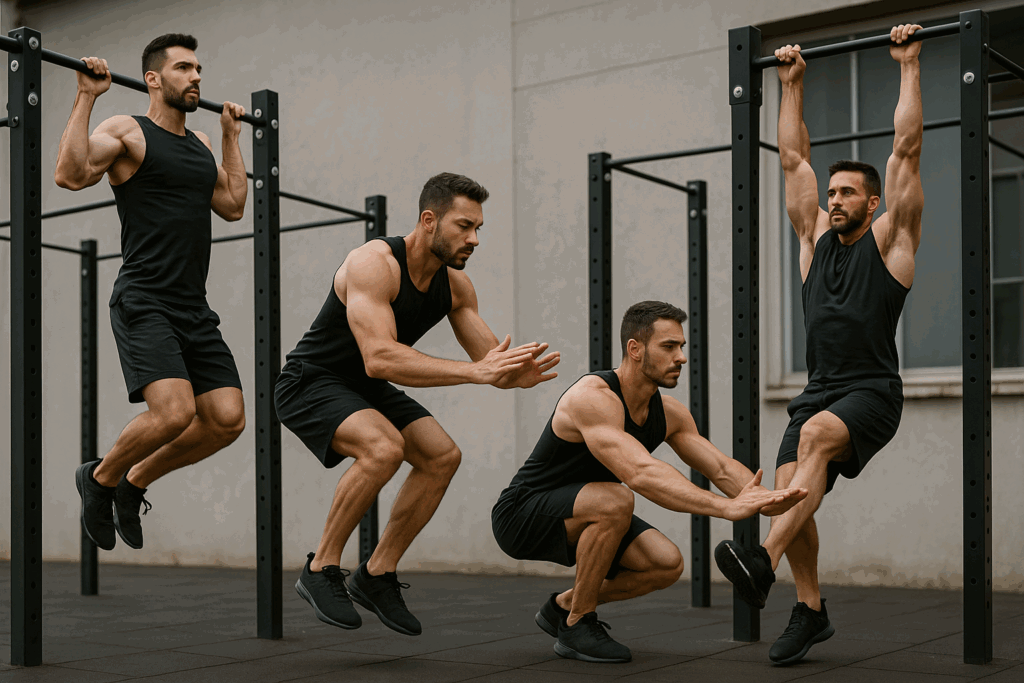
Structuring a Bodyweight Workout Guide for Results
A comprehensive bodyweight workout guide includes more than a list of exercises—it provides strategy, structure, and progression. One of the key elements is periodization: systematically varying training intensity and volume over time to avoid plateaus and overtraining.
Your guide should include cycles focused on hypertrophy (higher reps, shorter rest), strength (lower reps, longer rest), and endurance (high reps, minimal rest). Tracking variables such as tempo, rest intervals, and movement difficulty helps create consistent progress. Whether you follow a pre-written bodyweight training program for beginners or customize your own, intentionality is key.
Recovery, too, must be integrated into your training guide. Sleep, nutrition, hydration, and rest days directly affect performance and adaptation. With bodyweight training, the temptation to train daily is high due to the accessibility of the exercises—but balancing intensity and recovery ensures sustainability.
The Role of Skill Development in Bodyweight Training
Beyond hypertrophy and strength, bodyweight training uniquely facilitates skill development. Movements like handstands, planches, levers, and muscle-ups require not only strength, but also motor control, balance, and coordination. These skills elevate training beyond aesthetics and into true athletic mastery.
Integrating skill work into your bodyweight training plan introduces diversity and purpose. For instance, dedicating time to master a handstand builds shoulder and core endurance while improving proprioception. Transitioning to a muscle-up combines explosive pulling with technical execution. These goals inject playfulness and challenge into your routine.
Skill development also creates long-term engagement. Rather than chasing weight increases on a barbell, bodyweight athletes focus on mastering increasingly sophisticated movements. This evolution encourages persistence, humility, and continuous learning.
How to Progress from Beginner to Advanced in Bodyweight Training
The journey from beginner to advanced in bodyweight training is as much mental as it is physical. It requires patience, self-awareness, and strategic planning. Early stages focus on building foundational movement patterns, improving joint mobility, and understanding body alignment.
As strength improves, the introduction of unilateral movements and increased difficulty in exercise variations marks progression. A beginner may start with assisted squats or incline push-ups, move to standard variations, then advance to single-leg or plyometric options. Meanwhile, a structured bodyweight exercise program for beginners offers the roadmap for this evolution.
Advanced training often includes isometric strength holds, explosive training, and complex skills. The pace of progression depends on consistency, recovery, and quality of movement execution. Self-assessment, video feedback, and mentorship accelerate this growth by ensuring form and strategy align with goals.
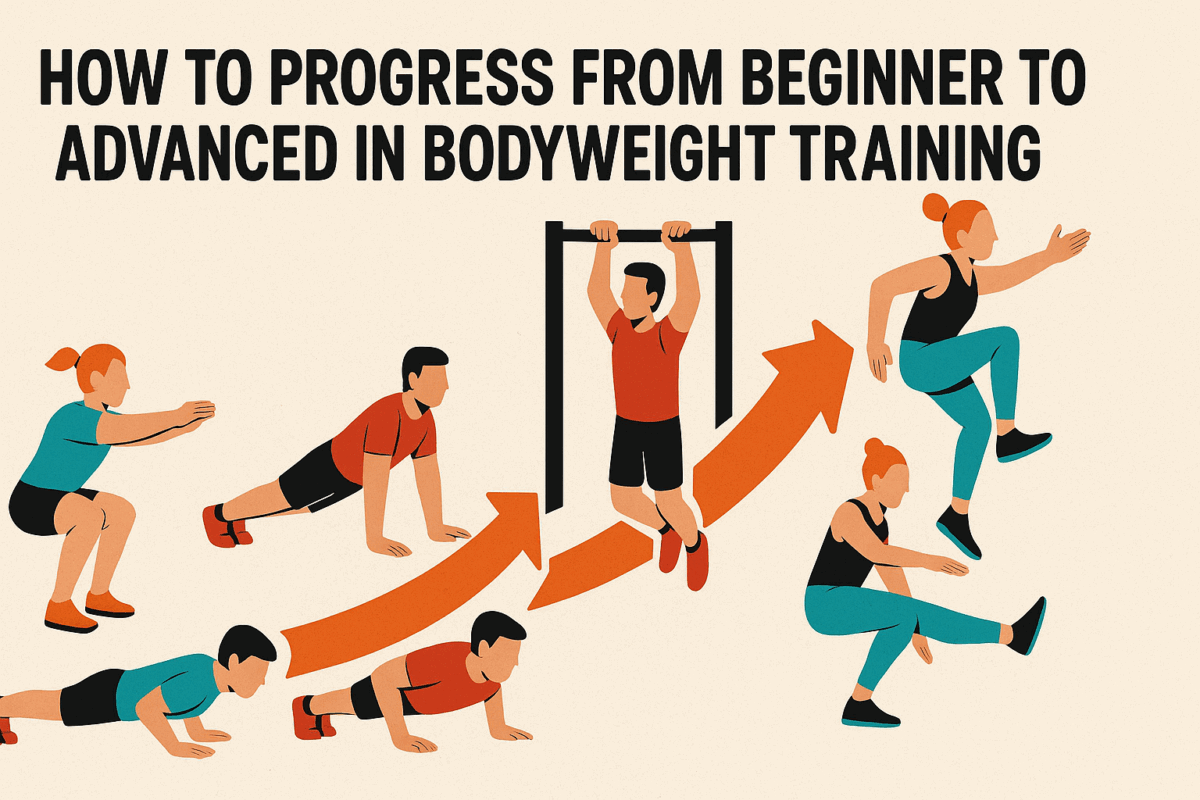
Combining Bodyweight Exercises into a Full Body Bodyweight Workout
One of the most efficient formats is the full body bodyweight workout. This structure enables comprehensive muscle stimulation in a single session, making it ideal for busy professionals or those preferring minimal equipment. Full-body routines promote systemic fatigue, elevate heart rate, and mimic real-life movement patterns.
A sample workout might begin with mobility drills, followed by circuits including push-ups, bodyweight rows, squats, planks, and lunges. Each round can be time-based or repetition-based depending on conditioning level. Alternating upper and lower body movements maximizes efficiency and maintains intensity.
Full-body routines also allow for strategic frequency. Training three times per week with different emphases (e.g., strength, endurance, power) provides ample volume while respecting recovery. These workouts can be adapted to target different muscle groups, energy systems, or skills depending on your focus.
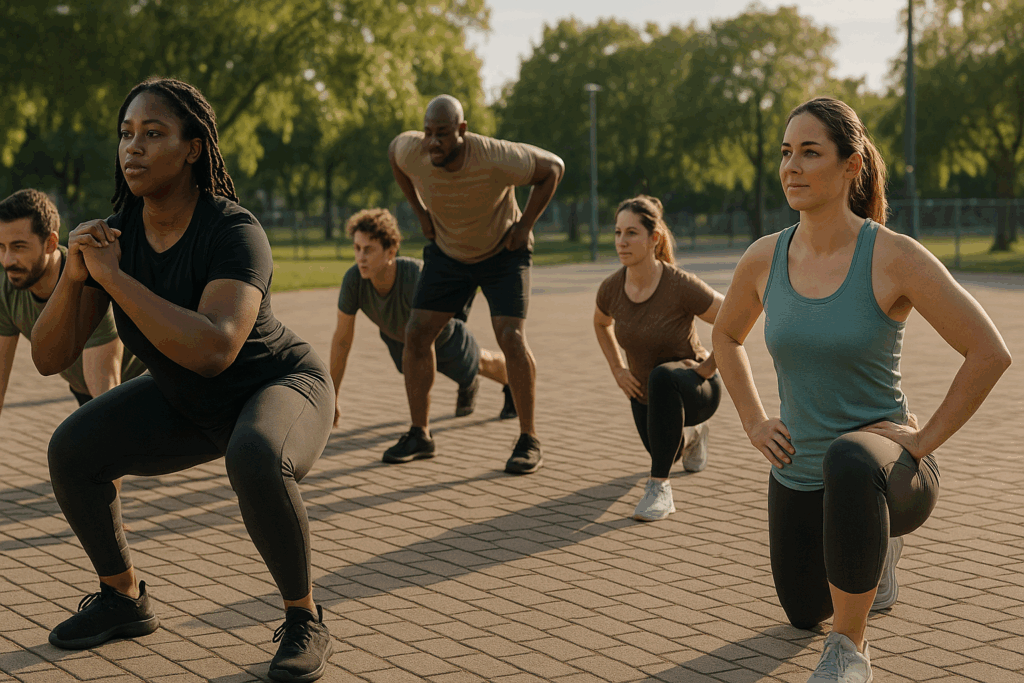
Frequently Asked Questions: Maximizing Results with a Bodyweight Strength Program
1. How can a bodyweight strength program be customized for different fitness goals?
A bodyweight strength program can be tailored to support a wide range of goals, from building muscle and increasing endurance to improving mobility and mastering calisthenics skills. For hypertrophy, the emphasis should be on controlled repetitions with longer time under tension. Those focused on endurance can incorporate circuit-style formats with higher repetitions and minimal rest between exercises. Mobility-focused individuals may benefit from integrating dynamic stretching, isometric holds, and range-of-motion training within their bodyweight workout routine. Additionally, athletes aiming for performance can prioritize explosive body weight exercises like plyometric push-ups and jump squats. Customization is all about adjusting variables such as rest, tempo, exercise variation, and training frequency.
2. What are the best bodyweight exercises for developing explosive strength?
Explosive strength is essential for athletic performance, and certain bodyweight exercises are particularly effective for developing it. Plyometric push-ups, jump squats, explosive lunges, burpees, and mountain climbers engage fast-twitch muscle fibers and promote power output. For upper body explosiveness, incorporating clap push-ups or muscle-up progressions is highly effective. In the lower body, tuck jumps and broad jumps help develop reactive force. These movements, when combined into a bodyweight workout plan, stimulate the neuromuscular system and enhance coordination. Training explosiveness should be done early in a session when the nervous system is fresh and always preceded by a proper warm-up.
3. Can bodyweight training build muscle mass as effectively as weightlifting?
Yes, when executed with strategic intensity and progression, bodyweight training can be highly effective for muscle gain. While external loads offer a simple way to increase resistance, bodyweight exercises rely on manipulating leverage, repetition volume, and movement complexity. For example, transitioning from regular push-ups to pseudo planche push-ups can increase difficulty significantly. A full body bodyweight workout using advanced isometrics and tempo manipulation can create the necessary stimulus for hypertrophy. The key is consistency and ensuring the program includes mechanical tension and metabolic stress—both vital for muscle adaptation. Recovery, nutrition, and proper form also play a critical role in maximizing results.
4. What role does mobility play in a bodyweight strength program?
Mobility is a foundational element in any successful bodyweight strength program. Improved joint mobility allows for greater range of motion during exercises, which in turn increases muscle activation and reduces injury risk. For example, performing deep squats or Cossack squats requires ankle, knee, and hip mobility to be safe and effective. Poor shoulder mobility can limit push-up depth or impede handstand progressions. Incorporating mobility drills such as thoracic rotations, hip openers, and scapular push-ups enhances movement quality. A balanced bodyweight training plan integrates mobility both during warm-ups and as part of active recovery.
5. How can someone break through plateaus in a bodyweight workout program?
To overcome plateaus in a bodyweight workout program, strategic variation and deloading cycles are essential. Introducing new movement patterns, altering tempo, increasing volume, or focusing on unilateral movements can reignite progress. For example, switching from basic lunges to Bulgarian split squats introduces instability and greater demand on individual leg strength. Additionally, reassessing recovery strategies—like improving sleep or nutrition—can unlock stalled performance. Mental fatigue can also hinder gains, so introducing new goals, such as mastering a skill like the muscle-up, can renew motivation. Plateaus are natural, but adaptive progression keeps the body responding.
6. What is the best way to structure a bodyweight training program for beginners?
A beginner-friendly bodyweight training program should prioritize consistency, safety, and mastery of movement fundamentals. Starting with a bodyweight beginner routine that includes squats, push-ups, glute bridges, rows, and planks ensures a balanced approach. The focus should be on perfecting form, building a baseline of muscular endurance, and developing body awareness. Sessions should include a proper warm-up, 2–3 sets of 6–12 reps for each movement, and ample rest between sets. Over time, the plan can introduce variations like tempo training and low-level isometrics to foster progression without overwhelming the trainee. Logging workouts and tracking progress builds accountability and reinforces habits.
7. How often should I do a bodyweight full workout for optimal results?
The ideal frequency for a bodyweight full workout depends on experience level and recovery capacity. Beginners may start with three sessions per week, focusing on full-body routines that hit all major muscle groups. Intermediate to advanced individuals can increase frequency to four or five sessions weekly, rotating emphasis between strength, hypertrophy, and skill development. Including one to two active recovery days with light mobility work enhances muscle repair. More frequent training requires close attention to sleep, stress, and nutrition. Varying intensity throughout the week—such as alternating heavy, moderate, and light days—helps sustain performance and avoid overtraining.
8. What’s the difference between a bodyweight exercise plan and a calisthenics skill-based program?
A bodyweight exercise plan typically focuses on general strength and muscle development through structured, progressive movements using only body weight. In contrast, a calisthenics skill-based program emphasizes mastering advanced movements such as levers, planches, and handstands, requiring not only strength but also technique and balance. While both can build muscle, skill-based training demands greater neuromuscular coordination and longer adaptation phases. Integrating elements of both in a bodyweight workout guide can offer a well-rounded routine. Understanding your goals helps determine which path or blend is best suited to your long-term development.
9. How does a bodyweight strength program support long-term health and aging?
One of the greatest benefits of a bodyweight strength program is its adaptability for long-term use, particularly as individuals age. Bodyweight exercises promote joint integrity, balance, and functional movement—all critical for maintaining independence and mobility in later years. Training regularly with bodyweight routines reduces the risk of age-related sarcopenia, improves posture, and supports metabolic health. For aging populations, movements such as chair squats, wall push-ups, and step-ups can be modified to match current ability levels. Since body weight workouts can be performed anywhere and require no equipment, they are ideal for maintaining consistency across decades of life.
10. What are some advanced techniques for maximizing muscle gains without weights?
Advanced bodyweight practitioners often use methods like mechanical drop sets, tempo manipulation, and pre-exhaustion to stimulate muscle growth without adding external resistance. Mechanical drop sets involve transitioning from harder to easier variations within the same movement—like going from archer push-ups to standard push-ups. Slowing down eccentric phases (e.g., 5–8 second descents) increases time under tension. Pre-exhaustion techniques involve fatiguing a muscle group with an isolation movement before a compound movement, such as hollow body holds before leg raises. Additionally, a structured bodyweight workout plan can use minimal rest intervals to maximize metabolic stress. These methods challenge the body in novel ways and drive adaptation through precision and creativity.
Conclusion: Why a Bodyweight Strength Program is a Powerful and Practical Solution
In the ever-evolving world of fitness, a bodyweight strength program stands out as a proven and accessible path to building real, lasting muscle without the need for equipment or a gym membership. By harnessing the body’s natural mechanics, individuals can progressively develop strength, mobility, and control with minimal risk and maximum functionality. This approach empowers people to train anywhere, adapt to any schedule, and prioritize long-term health through intelligent programming.
The science supports its efficacy: bodyweight workouts create the necessary stimulus for muscle hypertrophy and strength gains. The diversity of exercises, paired with scalable progression, makes this method suitable for everyone—from beginners establishing their first routine to advanced athletes refining complex skills. Full-body engagement, core integration, and movement fluidity ensure a holistic training effect that enhances both aesthetics and performance.
Ultimately, the true power of bodyweight training lies in its simplicity and versatility. With consistent effort, structured progression, and a growth-oriented mindset, anyone can leverage their own body to sculpt muscle, increase endurance, and transform their fitness. Whether your goal is functional strength, injury resilience, or body composition improvement, this program offers a sustainable and effective solution. Now more than ever, embracing your own body as your most reliable training tool might be the smartest move you can make.
Further Reading:
Can Bodyweight Exercises Build Muscle? (Yes, Here’s How)
Building Muscle with Bodyweight Exercises: A Beginner’s Guide



